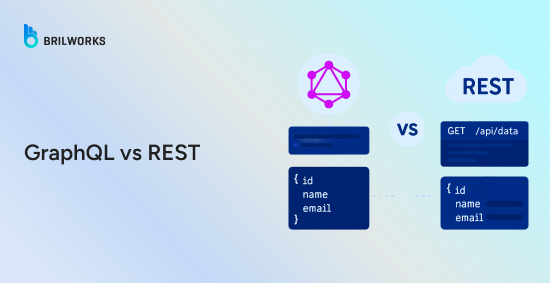COOPERATION MODEL
ARTIFICIAL INTELLIGENCE
PRODUCT ENGINEERING
DevOps & Cloud
LOW-CODE/NO-CODE DEVELOPMENT
INDUSTRY
FRONTEND DEVELOPMENT
CLOUD DEVELOPMENT
MOBILE APP DEVELOPMENT
LOW CODE/ NO CODE DEVELOPMENT
EMERGING TECHNOLOGIES








As a developer, you've likely hit a wall with your familiar APIs at some point. This is a common experience, and it's precisely why different types of APIs exist today. Sometimes the situation calls for a simpler option. When you figure out your current API approach isn't the best fit for the project you're working on.
While learning everything is a great trait for a developer, what truly makes you special is knowing when and where to apply the right solution. You're probably reading this because you've heard whispers about GraphQL and REST API, as answers to each other's limitations. This debate is common in the app development industry.
In this article, we'll dive into this common "GraphQL vs. REST" comparison. We'll weigh both against different parameters, offering use cases for each. Our goal is to help you figure out which one is the right choice for your next project, or simply to understand these fundamental approaches if you're a beginner.
REST was introduced by Roy Fielding as a simpler and more web-native option for distributed systems. It uses the HTTP protocol to activate communication between services. GraphQL came into the development scene as apps became more client-driven, around 2010. It helps developers to craft programs with lower network overhead.
Both REST and GraphQL are very popular choices for API design among Node.js developers.
REST (Representational State Transfer) is a popular way to build web applications that communicate with each other. It enables programs, like your phone app or a website, to get and send information to a server using the standard web communication rules (HTTP).
REST establishes the basic rules for communication among different parts of a web system. REST is stateless, meaning that every request that goes from a client to a server is completely independent of all prior requests; the server does not need to remember any prior state, as the request contains all the information it needs.
Further, there is client/server separation, which separates responsibilities: the client is responsible for the presentation (the things you see and interact with), and the server is responsible for creating and modifying the data and logic. REST is also a uniform interface. Finally, REST identifies its resources; it treats everything as a unique "resource."
GraphQL, a query language and runtime for APIs that was created by Facebook, is designed to allow clients to receive data from a single endpoint, requesting only the data they need. This is more flexible than REST APIs. GraphQL is schema-based, defining the types and relationships of data.
It builds a kind of contract about what to ask for. All client requests are made to the single GraphQL endpoint. It will allow clients to make flexible queries that specify the structure of the data, as opposed to being limited to an API defined structure.
|
Feature |
REST |
GraphQL |
Impact on Development |
|
Data Fetching Patterns |
Fixed endpoints, may over-fetch or under-fetch |
Flexible queries, fetch exactly what is needed |
GraphQL reduces unnecessary data transfer |
|
Versioning Approaches |
Explicit versioning via URL (e.g., /v1/users) |
Schema evolution, deprecate fields in schema |
Easier to evolve APIs in GraphQL |
|
Caching Mechanisms |
HTTP caching, CDNs, ETags |
Resolver-level caching, client-side caching |
REST leverages HTTP caching; GraphQL needs custom |
|
Request/Response |
Multiple endpoints, fixed response structure |
Single endpoint, customizable response structure |
GraphQL offers more control to clients |
|
Error Handling |
HTTP status codes, error messages |
Error objects in response, partial data possible |
GraphQL can return partial data with errors |
REST defines a primitive set of rules for resource relationship communication within web systems. REST is stateless, meaning that every request from a client to a server is completely independent of any previous request; the server will not need to remember any previous state, because everything it needs is included in the request. Further, they have client/server separation, which separates responsibilities:
The client is responsible for presentation (the things that you can see and touch), and the server is responsible for creating and modifying the data and logic. REST also contains a uniform interface. Finally, REST identifies its resources; it treats everything as a unique "resource."
Generally, REST handles versioning openly and explicitly for evolving APIs, often explicitly as part of the URL (e.g., /api/v1/users, /api/v2/users), which leads to service providers maintaining multiple REST API versions, increasing complexity to the consumer.
GraphQL allows for evolution simply in its schema; new fields can be added, and old fields can be deprecated rather than taking the approach of creating a new version. Creation is less disruptive to evolving an API.
The same goes for data caching: REST has a robust and inherent HTTP caching mechanism on the web that makes it relatively easier to implement caching strategies at multiple levels (meaning browser, proxy, and server). Generally speaking, GraphQL will require custom caching strategies because all requests go to (and through) a single endpoint, and requests are incredibly dynamic. That said, caching will likely need to be at a more granular level, i.e. custom resolver-level caching on the server, or more sophisticated client-side caching strategies.
Depending on the complexity of the data retrieval, the performance differences between REST and GraphQL will matter. Generally speaking, REST performs better for simple, simple requests of a single resource -- because it is directly tied to HTTP methods and is cacheable.
But, with more complex data retrieval needs, it is consistently better to use GraphQL since it allows the client to retrieve an arbitrary set of complex, nested, or deeply related data in a single request -- without needing to do multiple round trips required by the REST API to collect all of the related pieces of information. Thus, there are a considerable savings in network latency for complex queries.
Both of these structures can scale, just in different ways. REST scales well for APIs with basic resource-based interactions, low computing costs, statelessness, as well as strong caching support for horizontal scaling.
On the other hand, GraphQL scales better for APIs with a lot of complex data relationships and quickly changing frontend data needs. The ability to fetch just the right data in one request, plus scheme-changing flexibility, allows for greater efficiency with dynamically shaped applications versus a required, excessive API alteration on the backend and frontend changes on client side.
Decision Tree for Choosing Between GraphQL and REST:
Are your data requirements simple and stable?
└─ Yes → Use REST
└─ No → Do you need to aggregate data from multiple sources?
└─ Yes → Use GraphQL
└─ No → Is frontend frequently changing?
└─ Yes → Use GraphQL
└─ No → Use REST
REST is great in cases with fairly simple Create, Reads, Updates, Delete (CRUD) functionality, and is preferable when resources are limited on the client-side (such as mobile).
GraphQL is a more reasonable choice in cases which require manipulation of complex data or information. GraphQL may also work well with mobile applications.
In short: REST is preferable for simple, stable APIs and GraphQL is a good choice for more complex applications.
Ask these questions to yourself before deciding on GraphQL and REST.
If your data models are deeply intertwined with numerous connections between different entities (e.g., users, posts, comments, authors, tags), GraphQL's ability to traverse these relationships in a single query becomes highly advantageous. For simpler, flatter data structures, REST often suffices.
In situations where frontend features and data display requirements are rapidly changing, GraphQL client-driven query allows frontend teams the ability to adapt without continuous updates from backend teams. Because REST operates on fixed endpoints, more backend changes are usually required to accommodate new UI requirements.
If your API needs to consolidate data from various microservices, databases, or external APIs into a unified response, GraphQL excels as an aggregation layer, simplifying client-side data orchestration. REST would typically require clients to make multiple calls to different services.
For mobile application or areas where network connectivity is limited, reducing the amount of data transferred is essential. GraphQL's exact nature of data fetching is the solution to this, as it avoids over-fetching, in other words it only sends the data needed over the wire. REST has over-fetching potential in this regard.
When your application is fully dependent on built-in HTTP caching for performance and scalability (e.g., caching static resources or data that rarely changes), REST compliant with standard rest offers a key benefit. While GraphQL can be cachable, applications often need to create custom more complex caching layer.
Use this checklist as a quick reference when evaluating which API style is more suitable:
Choosing between REST and GraphQL depends on your project's needs. REST is great for simple, stable APIs, benefiting from standard web caching. GraphQL, however, shines with complex data, changing app needs, and mobile efficiency, letting you get exactly what you want. Pick the one that best fits your data, evolution plans, and caching strategy.
Need help building powerful APIs? Hire NodeJS developers with expertise in both REST and GraphQL.
No, GraphQL is not always faster than REST. GraphQL is great with complex, nested queries, but can add some overhead for smaller operations (REST can be simpler and faster).
REST security typically secures its endpoints, while GraphQL also focuses on your queries. Additionally, GraphQL security is more complicated because security measures like "depth" limiting and query complexity are needed to avoid a resource exhaustion attack.
REST security typically secures its endpoints, while GraphQL also focuses on your queries. Additionally, GraphQL security is more complicated because security measures like "depth" limiting and query complexity are needed to avoid a resource exhaustion attack.
GraphQL is an open-source query language and runtime for APIs, while Graph API specifically refers to Facebook's proprietary API that uses GraphQL principles to access their social graph data.
Get In Touch
Contact us for your software development requirements
Get In Touch
Contact us for your software development requirements